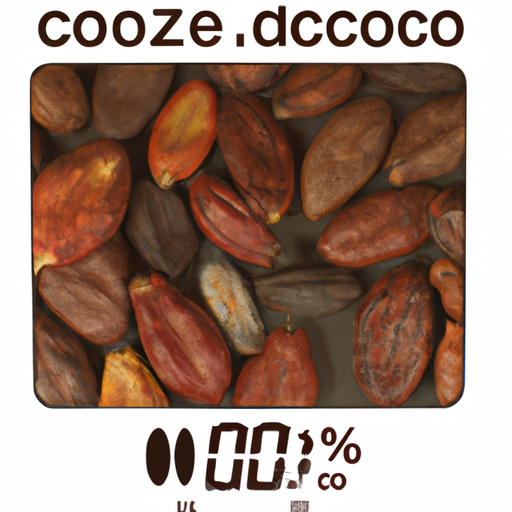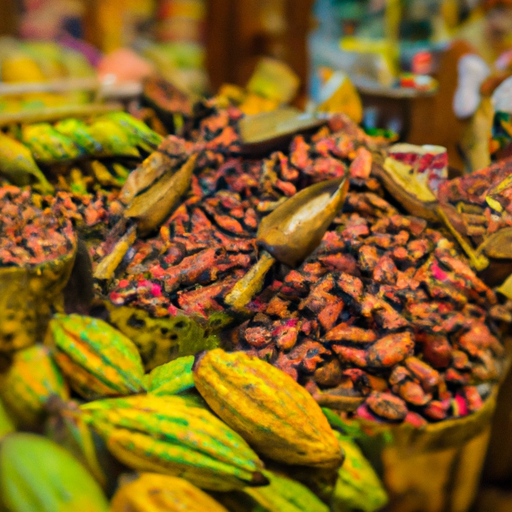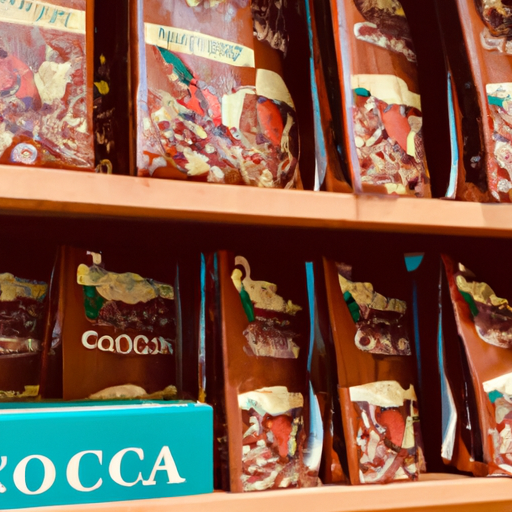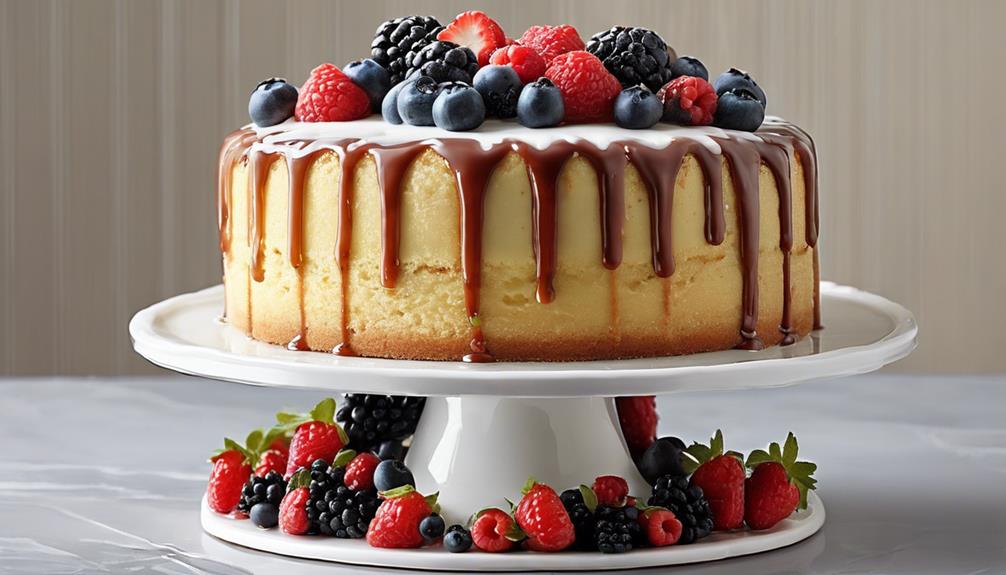I enjoy kicking off my morning with a mug of hot cocoa. It’s a great way to treat myself to something cozy and gain a little energy boost. Recently, I’ve become interested in the caffeine levels in raw cacao nibs, the most unadulterated form of chocolate. I’ve heard that they contain caffeine naturally, and I’m curious to find out the exact amount I’m getting.
In this article, we will explore the caffeine content in raw cacao nibs and its potential health benefits. We will also discuss how to manage caffeine sensitivity and other considerations when incorporating raw cacao nibs into your diet.
Additionally, we will explore alternatives to raw cacao nibs for those looking for a caffeine fix.
So if you’re like me and love the taste of chocolate but want to be mindful of your caffeine intake, join me as we dive into the world of raw cacao nibs and discover just how much of a kick they can provide.
Key Takeaways
- Cacao nibs contain caffeine, which can cause side effects such as jitteriness, increased heart rate, and difficulty sleeping if consumed in excessive amounts.
- It is important to be mindful of portion sizes and monitor overall caffeine intake from other sources when consuming cacao nibs.
- If experiencing unwanted side effects from consuming cacao nibs, it may be necessary to reduce intake or consult a healthcare professional.
- Cacao nibs can be enjoyed in moderation for their unique flavor and potential health benefits without negative effects, but it is important to pay attention to the body’s reactions.
What are Raw Cacao Nibs?
Raw cacao nibs are small pieces of crushed cacao beans. They possess a rich flavor and are widely known for their numerous health benefits. They are the purest form of chocolate, packed with essential nutrients and antioxidants.
Raw cacao nibs are a great source of fiber, iron, magnesium, and potassium. They also contain flavonoids, which have been linked to improved heart health and reduced inflammation.
Additionally, raw cacao nibs are known to boost mood and improve cognitive function due to their content of phenylethylamine and anandamide, which are natural mood enhancers.
However, it is important to understand the caffeine content in raw cacao nibs, as they do contain small amounts of this stimulant.
So, let’s delve into the topic of understanding the caffeine content in raw cacao nibs.
Understanding the Caffeine Content in Raw Cacao Nibs
Indulging in these delectable cacao nibs will give you a surprising jolt of energy, making you wonder just how much caffeine they contain.
Raw cacao nibs are known for their rich flavor and numerous health benefits, but their caffeine content is often a topic of interest. While cacao beans do contain caffeine, the amount is relatively low compared to coffee or tea. On average, raw cacao nibs contain about 1-15 milligrams of caffeine per ounce. However, the actual caffeine content can vary depending on factors such as the variety of cacao bean and the processing methods used.
It’s important to note that caffeine affects individuals differently, and its metabolism can vary from person to person. Some people may experience increased energy and alertness, while others may be more sensitive to its effects, such as difficulty sleeping.
Transitioning into the subsequent section about the health benefits of raw cacao nibs, it’s fascinating to explore how this superfood can nourish both body and mind.
Health Benefits of Raw Cacao Nibs
You’ll be amazed by the incredible array of health benefits that raw cacao nibs offer. From boosting your mood to enhancing your cognitive function and even improving your skin complexion.
Raw cacao nibs are packed with antioxidants, which can help protect your body against damage from free radicals. These antioxidants also have anti-inflammatory properties, which can reduce inflammation in your body and potentially lower your risk of chronic diseases.
Additionally, raw cacao nibs contain minerals like magnesium and iron, which are essential for maintaining a healthy body. They also contain flavanols, which may improve blood flow and lower blood pressure.
With all these health benefits, it’s no wonder that raw cacao nibs are often considered a superfood.
Moving on to the next section, let’s explore the potential energy boost that raw cacao nibs can provide.
Potential Energy Boost from Raw Cacao Nibs
If you’re looking for a natural way to boost your energy levels, try incorporating raw cacao nibs into your diet. These delicious little bites are not only packed with flavor, but they also contain caffeine, which can provide a much-needed pick-me-up.
Raw cacao nibs contain about 1-5 milligrams of caffeine per gram, which is significantly less than a cup of coffee. This makes them a great alternative for those looking to reduce their caffeine intake but still want to enjoy a slight energy boost.
However, it’s important to note that consuming too much caffeine can have potential side effects like jitteriness or insomnia. It’s recommended to limit your daily intake of raw cacao nibs to avoid these issues.
Transitioning into the next section about managing caffeine sensitivity, it’s important to understand how to enjoy the benefits of raw cacao nibs without overdoing it.
Managing Caffeine Sensitivity
When it comes to managing caffeine sensitivity, understanding individual tolerance levels is key. Each person has a different level of sensitivity to caffeine, so it’s important to pay attention to how your body reacts and adjust your intake accordingly.
Additionally, combining caffeine with other foods or beverages can also impact its effects. For example, consuming caffeine with a meal or alongside certain medications can either enhance or diminish its effects. It’s important to be mindful of these factors when managing your caffeine sensitivity.
Individual Tolerance Levels
To fully understand my own tolerance levels, it’s essential to take into account various factors such as my metabolism, overall health, and previous caffeine consumption.
Individual preferences and caffeine intake can also play a role in determining how much caffeine one can handle. Some people may be more sensitive to caffeine and experience jitters or anxiety even with small amounts, while others may be able to consume larger quantities without any noticeable effects.
It’s important to listen to my body and pay attention to how caffeine affects me personally. By doing so, I can better gauge my tolerance levels and make informed decisions about my caffeine intake.
Understanding my individual tolerance levels will help me navigate the next section about combining raw cacao nibs with other foods or beverages seamlessly.
Combining with Other Foods or Beverages
Combining raw cacao nibs with different foods or beverages can add a delightful twist to your culinary creations, enhancing flavors and providing a unique sensory experience. Here are three ways you can experiment with combining raw cacao nibs:
-
Combining with coffee: Add a sprinkle of raw cacao nibs to your morning coffee for a rich and indulgent flavor. The bitterness of the cacao nibs complements the smoothness of the coffee, creating a delicious combination.
-
Pairing with chocolate: If you’re a chocolate lover, try incorporating raw cacao nibs into your favorite chocolate recipes. Whether it’s cookies, brownies, or chocolate bars, the addition of cacao nibs adds a satisfying crunch and intensifies the chocolatey taste.
-
Other considerations for consuming raw cacao nibs: While combining raw cacao nibs with other foods or beverages can be enjoyable, it’s important to be mindful of your caffeine intake and individual tolerance levels.
Other Considerations for Consuming Raw Cacao Nibs
When it comes to consuming raw cacao nibs, there are a few other important considerations to keep in mind.
First, allergies and sensitivities to cacao are not uncommon, so it’s important to be aware of any potential reactions.
Additionally, moderation is key when it comes to consuming cacao nibs, as they are high in caffeine and can have stimulating effects if consumed in excess.
It’s important to listen to your body and consume cacao nibs in a way that works best for you.
Allergies and Sensitivities
If you have allergies or sensitivities, be cautious when consuming raw cacao nibs as they may trigger adverse reactions. Allergic reactions to cacao are relatively rare but can occur, especially in individuals who are sensitive to other foods such as tree nuts or pollen. Cross reactivity between cacao and other allergens is also possible, which means that if you are allergic to certain foods, you may also react to cacao.
Common symptoms of allergic reactions to cacao include hives, itching, swelling, difficulty breathing, and in severe cases, anaphylaxis. It is important to consult with a healthcare professional if you suspect an allergy or sensitivity to cacao.
Transitioning into the next section about moderation in consumption, it is crucial to be mindful of your intake to avoid any potential adverse effects.
Moderation in Consumption
Consuming an excessive amount of cacao nibs can lead to a higher risk of weight gain, as they are calorie-dense and contain a significant amount of fat. Therefore, it is important to manage your caffeine intake and consume cacao nibs in moderation.
While cacao nibs do contain caffeine, the amount is relatively low compared to coffee or tea. However, for individuals who are sensitive to caffeine, it is still important to be cautious. Potential side effects of consuming too much caffeine include jitteriness, increased heart rate, and difficulty sleeping.
It is always a good idea to listen to your body and adjust your consumption accordingly. Now, let’s explore how to incorporate raw cacao nibs into your diet without overdoing it.
How to Incorporate Raw Cacao Nibs into Your Diet
To fully experience the benefits of raw cacao nibs, you should explore various creative ways to incorporate them into your daily meals.
One great way to enjoy cacao nibs is by adding them to smoothies. Simply blend your favorite fruits and vegetables with some almond milk or coconut water, and then sprinkle a handful of cacao nibs on top for an extra crunch and burst of flavor.
Another delicious option is to use cacao nibs as a topping for desserts. Whether it’s a bowl of yogurt, a scoop of ice cream, or a slice of cake, cacao nibs can add a rich and chocolatey touch.
By experimenting with different recipes and combinations, you can find the perfect way to enjoy the unique taste and health benefits of raw cacao nibs.
So, let’s now explore alternatives to raw cacao nibs for a caffeine fix.
Exploring Alternatives to Raw Cacao Nibs for a Caffeine Fix
Now that we have explored how to incorporate raw cacao nibs into our diet, let’s delve into some alternatives for those seeking a caffeine-free fix.
While raw cacao nibs do contain a small amount of caffeine, there are several alternative sources available that can provide a similar flavor and texture without the stimulating effects.
One option is carob powder, which is derived from the pods of the carob tree and has a naturally sweet taste.
Another caffeine-free option is maca powder, made from the root of the maca plant, which is known for its adaptogenic properties.
Additionally, you can try using chicory root powder, which has a rich, coffee-like flavor.
These alternatives offer a delicious way to enjoy the benefits of raw cacao nibs without the caffeine.
So, let’s now move on to the conclusion: enjoying raw cacao nibs in moderation.
Conclusion: Enjoying Raw Cacao Nibs in Moderation
Remember, moderation is key when enjoying the delectable goodness of raw cacao nibs. Excessive consumption can lead to unwanted side effects such as increased heart rate or jitteriness. Here are three tips for managing your caffeine intake and avoiding potential side effects:
-
Be mindful of portion sizes: While raw cacao nibs are a healthier alternative to chocolate, they still contain caffeine. Stick to a reasonable portion size, such as a handful, to keep your caffeine intake in check.
-
Monitor your overall caffeine intake: Remember that raw cacao nibs are not the only source of caffeine in your diet. Keep track of your caffeine consumption from other sources like coffee, tea, or energy drinks to ensure you stay within a healthy limit.
-
Listen to your body: Pay attention to how your body reacts to consuming raw cacao nibs. If you experience any unwanted side effects, such as restlessness or trouble sleeping, consider reducing your intake or speaking with a healthcare professional.
By enjoying raw cacao nibs in moderation and being mindful of your caffeine intake, you can savor their unique flavor and potential health benefits without any negative effects.
Frequently Asked Questions
Are raw cacao nibs a good source of antioxidants?
Yes, raw cacao nibs are a good source of antioxidants. They are packed with nutrients and can be incorporated into various recipes to boost your overall nutrition.
Can consuming raw cacao nibs help improve mood and reduce stress?
Raw cacao nibs have been shown to improve mood and reduce stress. They can also aid in weight loss and promote cardiovascular health. Incorporating them into your diet may have positive effects on your overall well-being.
Are there any potential side effects of consuming raw cacao nibs?
There are potential risks associated with consuming raw cacao nibs. Long-term effects may include increased heart rate, insomnia, and digestive issues. It’s important to consume them in moderation and consult a healthcare professional if you have any concerns.
Can raw cacao nibs be consumed by individuals with caffeine sensitivity or intolerance?
Individuals with caffeine sensitivity or intolerance should proceed with caution when consuming raw cacao nibs. For example, a person with caffeine sensitivity may experience symptoms such as increased heart rate or nervousness after consuming raw cacao nibs. It is important to consult with a healthcare professional for personalized advice.
Are there any recommendations on the daily intake of raw cacao nibs for optimal health benefits?
For optimal health benefits, it is recommended to incorporate raw cacao nibs into your daily intake. These delicious snacks are packed with antioxidants, fiber, and minerals that can support heart health and improve mood.
Is the Caffeine Content in Raw Cacao Powder Different from Raw Cacao Nibs?
Yes, the caffeine content in half cup raw cacao caffeine can differ between raw cacao powder and raw cacao nibs. Raw cacao powder undergoes a process that may result in a slightly higher concentration of caffeine compared to raw cacao nibs.
Conclusion
How much caffeine is in raw cacao nibs?
Raw cacao nibs do contain caffeine, but the amount is relatively low compared to other sources. On average, a tablespoon of raw cacao nibs contains about 12 milligrams of caffeine. To put this into perspective, a cup of coffee typically contains around 95 milligrams of caffeine. So, while raw cacao nibs can provide a little energy boost, it’s important to keep in mind that the caffeine content is relatively low. Enjoying raw cacao nibs in moderation is key to reaping their potential benefits without overdoing it on the caffeine intake.










